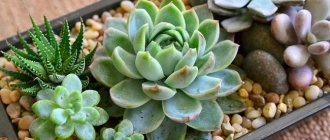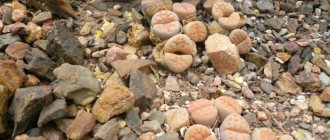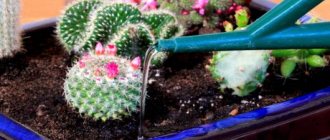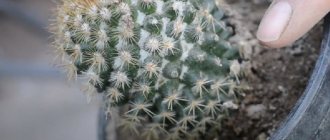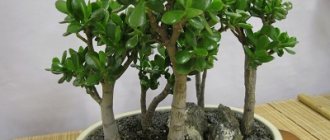How to transplant succulents after purchase
If a new flower from the store appears in the house, it should definitely be replanted. Crops are often sold in containers with special transport or regular soil, which is not suitable for long-term cultivation. The flower should be placed in new soil within the first week after purchase. If the soil in the temporary container is dry, you can replant it immediately. The wet soil is allowed to dry for several days, which will also be useful for the plant’s adaptation to new conditions. Special soil for transplanting succulents is sold in specialized flower shops. To improve drainage properties, the substrate is mixed with a small amount of river sand.
Photo of the moment of transplanting the purchased succulent into a new pot
When preparing soil for succulents, the following components are used independently: soil, sand, peat (can be replaced with humus). They are mixed in a ratio of 1:2:1. If the cactus variety is more moisture-loving, one part of the sand is replaced with soil. The resulting soil mixture must be loose; in hard, lumpy soil it will be difficult for the flower to develop.
The presence of a drainage layer is also important. It is placed on the bottom of the container, in a layer of about 2 cm
Drainage allows you to remove excess water from the ground, normalize microflora, and prevents moisture retention in the rhizome and its rotting.
It is worth noting that for planting succulents, soil, sand and materials chosen for drainage (for example, rock chips, pebbles, etc.) must be disinfected. To do this, bulk materials are calcined in the oven, the pebbles are thoroughly washed, and soaked for some time in a light solution of manganese. An undisinfected soil mixture can cause the development of pathogenic bacteria and the spread of various diseases among exotic representatives of the flora.
After preparing the necessary materials, the succulents are actually transplanted. When replanting cacti, get thick gloves in advance. Foam rubber will also come to the rescue. With the help of its dense small pieces, you can move the crop without pricking your hands. Using foam rubber helps not to harm the crown and keeps all the existing thorns in place.
How to regularly replant succulents
Transplantation is carried out in two ways. The first is the transfer method, when the plant is placed in a new container with a lump of soil in which it grew before. This option is gentle and allows less damage to the roots. The second method involves completely clearing the rhizome from the soil and removing its damaged parts. The roots are cleaned using a sharp knife; the sections must be treated with an antiseptic. If the soil is sticky and makes dry cleaning of the rhizome difficult, it is recommended to soak it under running water or place the succulent in a bath of water for a while. After cleaning the rhizome, you should give it time to dry thoroughly. The prepared culture is planted in a container.
During replanting, you should inspect the roots of the plant for any signs of pests or rot. Don't be afraid to trim the roots - it's useful and stimulates their growth. The planting steps look like this:
- Selecting a pot, laying a drainage layer (1-2 cm) on its bottom.
- Filling with prepared soil mixture.
- Planting a seedling, filling its roots with the remaining soil mixture. You need to fill it up so that the neck connecting the lower and upper parts of the crop is visible. The soil mixture is lightly compacted.
- Filling the top layer with rock chips.
How to water succulents after transplanting
Many gardeners have a legitimate question whether it is necessary to water succulents after replanting, because traditionally most plants are moistened after such manipulations.
If you replanted the plant using the transshipment method, you can immediately moisten the soil.
In this regard, there is a special approach to succulents, depending on the transplantation method:
- When planting by completely freeing the rhizomes from the soil, they cannot be watered. Considering their ability to accumulate moisture in the stems, they contain enough nutrients and do not need frequent watering. The first watering is carried out after 3-4 days, using warm, settled water.
- When replanting using the transshipment method, you can water it with a small amount of water immediately after completing the procedure.
Also, in the first week after changing the container and soil, it is not recommended to keep the cactus in bright sun. It is better to place it in partial shade, giving it the opportunity to rest and recover.
How to properly replant succulents
Watering should be stopped 7–8 days before transplanting. It is best to start work in clear weather.
The transplant includes several stages:
- Carefully remove the plant from the pot, avoiding any tension. To better separate the soil from the walls and bottom of the pot, you need to knock on them first. If the pot is plastic, then the walls can be squeezed.
- Lightly shake the earth ball, getting rid of the remaining substrate. Then the root system is cleaned with a brush. Scissors remove diseased, damaged and dry roots. The sections are treated with crushed charcoal. If white spots are noticeable on the roots, which indicates the presence of pests, then you need to treat the plant with an insecticide.
- Drainage is placed at the bottom of the pot (you can use gravel, crushed stone, brick chips, expanded clay, vesiculite, foam) to prevent moisture stagnation.
- Fill some soil over the drainage and install the plant, straightening the roots. Then fill the entire space with soil, compacting it. A centimeter layer of sand is poured on top of the substrate.
- The soil is slightly moistened. Water the flower only every other week. You can fertilize no earlier than a month later.
Large plants are replanted using the transshipment method - with a lump of earth.
Money tree as a talisman to attract money
According to the recommendations of Feng Shui experts, planting a money tree provides people with financial success and well-being. There are many signs and superstitions associated with the plant.
It is advisable to pay attention to the following:
- To make a profit, it is recommended to communicate with a fat woman. The best day of the week is Wednesday. They tell the money tree about financial problems and ask it for help and success. They do it with soul.
- When wiping the leaves, it is recommended to count them. Each leaf symbolizes a coin, and money, as you know, loves counting.
- For planting, choose a red pot. If this is not the case, then the problem is solved in another way - they tie it with a red ribbon or apply patterns on it with red paint.
- After the profit has appeared, a few coins are placed in a pile near the pot. This enhances the effect of the money tree as a talisman.
Note! Often the appearance of a money tree in the house helps solve many problems. It is recommended to follow the rules for caring for the plant
Particular prosperity in the house is expected when the money tree blooms. At home, this rarely happens, so the appearance of flowers on a plant is a favorable sign.
A money tree can even be grown from a leaf.
If the pot suddenly fell and broke, this is not a negative sign. The phenomenon suggests that material well-being, on the contrary, will improve. In this case, envious people may appear.
It is important to provide a good place in the interior for the flower. There should be no bright or contrasting colors in the room
How to use coconut substrate?
Few people know how to properly use this product and plant plants in it. If you choose a substrate in the form of briquettes, they must first be soaked. This is done simply: the material is placed in a deep container and filled with warm or hot water. During the work, as it is absorbed, the liquid is gradually added.
The substrate will begin to increase in size and fall apart. A briquette weighing 1 kilogram will yield about 6 kilograms of soil, ready for planting. Some experts advise rinsing the product with high-temperature running water after swelling. To do this, the substrate is covered with gauze; nylon products can also be used.
The moistened substrate is sent to a container with drainage lined at the bottom, after which the plant is planted in it. Then the mixture needs to be fertilized. Compositions containing nitrogen are best suited for this. They also use special complex formulations intended for plants of various varieties.
Subtleties of transplantation
When replanting a fat plant after pruning, it is best to choose a shallow and wide container for this, taking into account the characteristics of the plant’s root system. In order for the Crassula to stand steadily, the width of the pot must correspond to the size of the crown. A narrow, high pot can completely stop the growth of a tree. Therefore, it is necessary to replant the money tree into a wide flat container not only after pruning, but also if it is not growing well. A heavy ceramic pot is ideal.
Replanting can be done quite often, even once every six months, by transferring the plant along with a lump of earth from one container to another and adding new soil on top. Transferring it to a wide pot will speed up the growth of the plant and make it more beautiful and healthy. You should not break off the leaves at the bottom of the trunk; they will fall off on their own over time, and until then they will serve as feed for it.
A layer of expanded clay should be placed at the bottom of the pot, and a mixture for cacti and succulents should be used as soil. You can prepare the soil yourself: mix coarse sand, leaf and turf soil in equal proportions, adding half a portion of peat to them. It is best to place the plant on the southeast side of the apartment, which can be determined by using a compass.
Since the money tree is constantly reaching for the light, you will have to regularly turn the pot so that the branches and trunk of the plant do not bend. You should also protect it from cats, who for some reason love to rub their faces and backs against it, after which the leaves simply fly off and fall off. Otherwise, caring for the plant is not difficult.
What you need to prepare
First you need to purchase (or select from existing) the necessary equipment. Needed:
- pot;
- narrow scoop or spatula;
- knife or blade;
- potassium permanganate solution.
Of all the above, the most difficult will be choosing a container for planting.
When choosing the size of the pot, you should consider several nuances:
- for stem succulents, the transverse size should be two to three centimeters larger;
- for leafy ones, it is important to correlate the depth and width of the pot with the type of their root system;
- For spreading and tall varieties, stability is important.
Equally important for all plants is the presence of through holes to drain excess water. If the tray spoils the appearance, you can use a flowerpot with a container inserted inside. Plastic, ceramic or glass pots are often used for succulents. Each of them has its own advantages and disadvantages. You can use any utensil or household container you like as a pot, as long as it meets the requirements - it is the right size and will not retain moisture. Both new and already used containers must be washed and doused with boiling water before the planting procedure.
Characteristics and use of hydrogel
Relatively recently, hydrogel appeared in floriculture stores.
This product immediately attracted the attention of buyers due to its amazing appearance. The product may be sold in the form of granules, powder or crystals
It is able to absorb and retain moisture. When wet, the elements increase significantly in size. Manufacturers have added safe dyes to their composition, thanks to which the granules are full of a variety of colors.
Larger hydrogels are used as a substitute for substrates and soils for houseplants. Plants are planted in transparent containers, creating amazing living compositions. The fine product is mixed with soil. This composition is often used for germinating seeds.
Often the product acts as a decorative addition to the interior. By mixing several bright colors in one transparent container, you can add color and expressiveness to your decor. Such an element will become an accent and complement the style.
The technology of filling the pot has its own characteristics.
- Up to a third of the container can be occupied by the lowest drainage layer - pebbles for water outflow. They are disinfected with potassium permanganate and dried well.
- Next comes the soil mixture. It’s more convenient to use a ready-made one from the store. It is quite difficult to prepare a mixture for succulents yourself, since this word implies many varieties. For some of them, the nutritional value of the soil is important, for others it can even be harmful. The easiest option is to mix cleaned turf and nutrient soil. It is better to take it under the leaves, clearing it of grass, debris and roots. To prevent such soil from clumping, sand, peat, charcoal, and small stones are added to it. All components must be disinfected by keeping them in the oven. Coconut substrate deserves special attention. It can be used in its pure form or mixed with soil in a one to one ratio. Such soil will be moderately nutritious, loose, with good air exchange. The pressed substrate is pre-soaked, dried and only then laid as soil. Otherwise, you may make a mistake in the volume.
- You can scatter sand or drainage pebbles on top around the plant.
Why is a transplant needed?
There are several reasons to repot succulents.
- Prevention after purchase. When purchasing a plant from hand or in a store, you can never be sure of the correct planting and the quality of the soil. Therefore, it is better to carry out this procedure yourself.
- Diseases. If any damage is detected, the first thing to do is to inspect both the plant itself and its roots. And then begin treatment by placing it in new soil.
- Inconsistency between the size of the plant and the pot. Moreover, this applies not only to the roots, but also to the trunk with leaves. In the first case, crowding can cause poor growth. In the second, the above-ground part can simply outweigh the pot.
- Poor soil condition. If the contents of the pot are compressed and form a dense lump through which water cannot seep, it needs to be replaced. Often in such cases a gap forms around the perimeter of the pot.
- Accidents. Pots rarely fall. In this case, it is better to carry out the entire transplantation procedure again and not try to eliminate only external traces of the fall. It is quite possible to reanimate a broken part of a succulent.
When to replant
Succulents grow slowly, and the issue of replanting into a new flower pot may not bother the gardener for a couple of years. In addition to the desire to change the flower pot to a container of a different design or color, there are also objective signs when replanting cannot be delayed.
These factors include the following:
- during irrigation, water stagnates on the surface of the soil and does not penetrate down;
- the roots are cramped in the flower pot, they are even visible from the drainage holes;
- the pot size is too small for the plant;
- the soil mixture is in poor condition - depleted, spoiled.
Even if there are no objective reasons, the plant should be replanted every two years. The optimal time for replanting is early spring.
Replanting succulents after purchase is a mandatory hygienic procedure. It is especially important to carry this out when the source of the plant is questionable.
Options for growing succulents
To answer the question of how to plant succulents, you first need to become familiar with their reproduction processes. There are several options. Plants can be propagated using cuttings, leaves and seeds. If you follow all the recommendations from experts, then any of this methods will be effective, and a new representative of your home flora will quickly appear on the windowsill. And over time, you will even have to think about how to replant succulents.
Propagation by leaves is only suitable for those types of succulents in which they are thick and fleshy. For varieties with thin leaves, propagation by cuttings is used.
First of all, you need to properly prepare the planting material. To do this you need:
- Choose a completely healthy leaf or cutting.
- Take a sharp knife and wipe it with a disinfectant.
- Cut off the leaf/cutting at the very base.
Note! There is no need to immediately plant the taken shoot in the ground or put it in water. It should lie down for about 2 days and dry out a little.
If juice is released from the cutting, it should be washed off with filtered water, and then the cut area should be sprinkled with crushed activated carbon. Then the cutting can be germinated in water, but you just need to make sure that it does not touch the bottom of the container. You can also germinate planting material in fine-grained sand. To do this, the cuttings are planted no deeper than 2 cm and are well fixed with fine gravel. The planted plant must be watered.
The germination process will be successful if the room maintains a stable temperature of about 23-25 °C. The root remedy will also benefit the plant.
Kornevin - growth accelerator
The leaf is rooted a little differently. For it you need to prepare well-disinfected soil. For this, either sand or a special substrate purchased in a store, to which sand or fine-grained expanded clay is added, is suitable. There is no need to plant the leaf in the ground; it is placed on dry soil at an angle so that it is convenient for it to take root.
Next, the shoot needs proper care.
- There is no need to water the leaf; it must be sprayed periodically.
- The pot is placed in a bright place, but drafts and direct sunlight must be excluded.
- When the leaf has roots, it is planted in a special substrate for succulents.
- When the top layer of soil dries, the sprouted leaf needs to be watered.
Note! The cuttings sprout new shoots and acquire lush foliage, but the leaf, on the contrary, dries out, so there is no need to be afraid that the plant has not taken root, everything will be fine with it
Plant families with succulents
Cactaceae (Cactaceae, about 2000 species) are predominantly leafless, stemless succulent plants. Their characteristic areoles covered with spines (modified short growths).
Euphorbiaceae (Euphorbiaceae, about 8000 species) contain milky sap. Stem succulence is found in relatively few species, representatives of American cacti from arid regions.
Crassulaceae (Crassulaceae, about 1400 species) - a purely succulent family, mainly of succulent letters and less commonly with succulent stems. Distributed mainly in South Africa, Mexico and the Mediterranean. A typical sign of most species is a blocked shoot.
Agaves (Agavaceae, about 400 species) are recognized by the typical rosette arrangement of succulent leaves and inflorescences in the form of a panicle or brushes. It takes several years or even decades before the agave blooms. After this, the mother plant dies.
Lily (Ltiiaceae) genera (sometimes a separate family) with succulent leaves - Aloe, Haworthia and Gasteria. They come from Africa.
Succulent orchids (Orchidaceae) with fleshy false bulbs and thick leaves living in epiphytic, low-water areas.
An important feature of cacti and other succulents is their leaves and stems, which are adapted to drought. Stem succulent plants have a thickened shoot axis with specialized tissue that stores water (cacti, milkweed). Their leaves are often reduced or completely absent. Sometimes they turn into spines (for example, in cacti, not into thorns, as they are mistakenly called). These leaf spines are actually sharp, modified leaves that serve to protect against moisture evaporation and herbivores.
Leafy succulent plants, on the other hand, enhance their leaves as an organ that stores vital moisture. Their leaves are thick and succulent (eg in agave, aloe, living stone).
Aeomum tabuliforme needs sun and fresh air all year round. The plate-like rosettes consist of 200 individual leaves. Propagated by seeds.
General description and main varieties of succulents
A unique feature of succulents is that they are able to accumulate liquid in the tissues of the stems and modified leaves.
The name of the plants comes from the Latin word succulentus (abundant with juices); moisture and mucus accumulate in their succulent leaves, so they can do without watering for a long time:
- aeonium and cotyledon, synadenium and pachyphytum;
- fucaria and portulacaria, conophytum and boviea;
- pedaoanthus and adromiscus, jatropha and argyroderma;
- pyaranthus and albuca, hatiora and monanthus;
- apthemia and brinamia, euphobia and lithopus.
A general description of succulents allows them to be distinguished from other plants, and they can be leafy or stem-based.
Earth for adenium - composition
The composition of the soil is determined depending on the conditions in which the succulent will grow. The location of the pot with the plant determines the mode of supply of moisture, fresh air, and light.
To understand how to best select soil for adenium for replanting, it is necessary to consider three typical examples.
The soil for adenium should be very loose
Optimal temperature and natural light
The most suitable conditions are when adenium is kept year-round at a temperature of +25 ° C and above, in bright light for more than 10 hours a day.
The soil for adenium may contain more nutrients, as the plant has the opportunity to reach its growth and flowering potential. Mix:
- deciduous humus soil – 50%;
- perlite and vermiculite in equal parts - 30%;
- charcoal – 20%.
Such a substrate will require regular feeding, but the tree can be replanted only after the roots have filled the entire volume of the pot.
Temperature is normal, lighting is artificial
Sometimes natural light is not enough. In this case, in winter, additional electric lighting is provided until the required length of daylight hours (10-12 hours). The air temperature is limited to the range of +22-25 °C.
Even with additional lighting, the succulent will grow slower than in the open air. This requires reducing the amount of nutrients in the soil.
The optimal composition of the substrate is as follows:
- soil for succulents – 30%;
- coco soil – 30%;
- vermiculite and perlite in equal parts - 30%;
- charcoal – 10%.
Important! Adenium is fertilized only as needed, very rarely. You can use ready-made nutrient solutions only in their half concentration
Low temperature and lack of light
If the air temperature is about +20 °C, and there is no artificial lighting, such an environment will have a negative impact on the development of the tree. It is impossible to compensate for the lack of light. The heat- and light-loving plant will survive, but will grow slowly, and with the slightest waterlogging or hypothermia, its roots will tend to rot.
The permissible soil content is as follows:
- coco soil – 60%;
- zeolite and perlite in equal parts – 30%;
- charcoal – 10%.
Important! If there is a lack of heat and lighting, the composition of the substrate should be extremely poor in organic matter
How to properly care for succulents
Temperature and humidity conditions
This type of plant tolerates temperature changes well, but it should not be below 5 °C, otherwise the succulent may die. To create an optimal climate, the room in which the plant is kept must be regularly ventilated. In summer, flower pots can be taken outside.
It is not recommended to spray succulents with a spray bottle, as excess moisture may cause them to rot.
How much light do you need
Echeveria flowers
Lighting recommendations for succulent plants depend directly on their variety. Some plants prefer direct sunlight, while others require partial shade.
Almost all varieties do well on windows located on the east and south sides.
Close to natural soil
Soil preparation
The soil for succulent crops should not be too dense and heavy, as they quickly die in it. The optimal soil mixture consists of:
- drainage from 1/3 to 1/6 from the bottom of the pot (depending on the variety);
- coarse sand with pebbles, garden soil and humus in a ratio of 2:1:1;
- small pebbles, crushed brick or expanded clay 1-1.5 cm above the ground.
Watering mode
Succulents should be watered only if the soil has dried at least 4 cm. For this, use only well-settled water without chlorine impurities. When irrigating, you should try not to get it on the leaves or pour water under the roots.
The frequency of watering succulents directly depends on the temperature of the room in which the plant is located and the time of year:
- In winter, at a temperature of 6–9 °C, it will be sufficient to irrigate the plant once every 2-3 months, at 10–14 °C – once a month.
- From the beginning of spring to the end of autumn, at a temperature of at least 18 ° C, it is necessary to water succulents 1-2 times a week. In this case, it is necessary to focus on soil moisture.
- In extreme heat, you can irrigate the plants more often - once every 2-3 days.
Selection of fertilizers and feeding regime
Succulents need to be fertilized very carefully. Improper feeding can cause plant death
They begin to add nutrients to the soil during the growing season, which begins in the spring. The interval between feedings should be at least four weeks.
Fertilizers are selected depending on the problem:
- with a weak root system and chlorosis, the plant needs calcium;
- when growth stops and inflorescences fall off - in iron and nitrogen;
- in the absence of flowering and leaf fading - in magnesium;
- if the formation of children is too intensive - in zinc.
Proper planting and replanting
Experts recommend steaming any mixture, store-bought or homemade, well in the oven. To do this, lay wet sand on the bottom of the flowerpot, and the remaining components in the next layer.
Thanks to such actions, hot steam will rise from the sand and disinfect the soil. After steaming, the soil will be cleared of all microorganisms. A month later, after transplanting into such soil, it is necessary to carry out treatment with the help of special biological preparations.
When replanting succulents, you need to consider the size of the pot. Its diameter should be several centimeters larger than the previous one. Young flowers should be replanted annually, adult and large plants - once every three years.
For fast-growing succulents, it is best to transplant using a transshipment method.
It is optimal to transplant in early spring; during this period of the year, plants begin to grow intensively. It is necessary to lay drainage made of fine expanded clay at the bottom of the container. You can also sprinkle expanded clay or pebbles on top of the planting soil, this will save the root collar from rotting.
Immediately after transplantation, the plant should not be watered; it should stand for several days to adapt. It is also not recommended to water the flowers before transplanting, about a week.
Caring for succulents at home is quite simple. In the hot season, flowers are watered abundantly 2 times a week, and additional fertilizing is applied. In the winter season, the frequency of watering is reduced to once every seven days, as daylight hours decrease.
In winter, you don’t have to moisten the plant at all, as it can go without water for a long time. When a succulent wilts, you need to water it.
Such flowers need sunlight. Without insufficient light, plants' growth and development slows down. These plants can be exposed to direct rays of the sun and nothing bad will happen to them, since they are characterized by protective elements from excess light.
Succulents can easily tolerate sudden changes in temperature. But they have a negative attitude towards cold. In summer, it is optimal to take the pot with the plant to the balcony, because there is good air circulation.
If you take proper care of succulents and choose the right soil for them, the plants will develop and grow well at home.
How does seasonality affect replanting succulents?
This procedure has little to do with the movement of the moon, but it differs from the time of year. Traditionally, the plant is replanted in the spring, in April-May, before the onset of the active phase of the growing season. During this period, the flower has more strength and is less susceptible to various manipulations and minor damage. Transplanting succulents in winter is possible, but it is advisable to do it using the transshipment method. During the dormant period, the flower will take longer to adapt to new conditions.
Spring is the optimal time to transplant succulent crops.
During the flowering of the cactus, it is recommended not to undergo any traumatic procedures, including planting. This can cause the buds to fall off, and is also fraught with a long adaptation period. It is better to postpone the procedure until the end of flowering.
In the future, adult succulents are replanted as needed (every 3-4 years). The main signs that you need to move the cactus to another container are:
- the roots are visible from the hole in the bottom of the pot;
- the earthen lump has gone astray, is excessively compacted, which prevents the plant from developing;
- rotting of the rhizome due to excessive moisture;
- the earthen ball has “swollen” due to an increase in root mass and insufficient space for growth.
The rules we have described are easy to follow, and following them will help the intensive development of the flower. We hope that your favorite bush will always delight you with its lush greenery and lush buds.
To conclude our article, we would like to share with you a video in which a famous succulent collector conducts a master class on replanting Aeonium
Home care
When growing succulents, you should distinguish between winter and summer care. In the warm season, plants should be watered no more than twice a week. At this time, the plant is actively growing, so regular feeding is needed. In winter, watering is reduced to twice a month, and fertilizing should be stopped completely.
Important! Succulents and cacti cannot grow well without sunlight. They are not afraid of direct sunlight, so they can be safely placed on the windowsill
In winter, for more light, it is better to place pots with succulents close to the glass. This will help lower the temperature by 2-3 C and increase the lighting of the plant.
Succulents can be replanted in both spring and summer. Inspecting the succulents will help determine the need for replanting. The following signs will indicate the need for this procedure:
- A gap has formed between the pot and the soil.
- Roots emerged from the drainage holes.
- The size of the plant exceeds the volume of the flowerpot.
Both professionals and beginners can replant succulents at home. The transplant must be carried out following the following steps:
To transplant succulents and cacti, prepare a pot, soil, drainage and hand protection. In addition to gloves, it can be foam or thick cardboard. About a week before transplanting, stop watering the plant. If the succulent is healthy, then it can be transplanted using the transshipment method
If it is necessary to inspect the roots, carefully remove the dried soil. The plant is placed in a new pot and covered with substrate. After watering, the top layer is covered with pebbles or expanded clay.
To provide exotic species of succulents with an optimal microclimate, they can be planted in special florariums. These are special glass or transparent plastic vessels with a narrow neck. Often it is closed with a stopper. Quite often they are equipped with a heating and lighting system.
When creating a succulent composition, you need to choose plants from the same area. They should have similar watering regimes and lighting needs. If you do not take this rule into account, the plants will quickly die.
The right approach and adherence to the rules of care will help you grow not only familiar plants at home, but also surprise your guests with plants from other countries. By combining succulents of different shapes and colors, you can create a beautiful composition that will decorate your home.
When to replant
The plant needs replanting if:
- roots begin to crawl through the drainage holes;
- when watering, water does not penetrate into the soil, but stands on the surface;
- the substrate separates from the walls of the pot or dries out too quickly;
- The succulent is significantly larger than the size of the pot.
Immediate replanting is required for plants purchased at a flower shop. They are planted in special transport soil, which is not suitable for permanent cultivation.
It is recommended to replant young plants (1–3 years old) annually, and older plants (4–10 years old) once every 2–3 years. Large succulents do not need to be replanted; it is enough to regularly apply fertilizer or change the top layer of soil annually.
It is believed that the ideal time for transplanting indoor flowers is spring, when the growing season begins, which promotes rapid establishment and adaptation. But some gardeners argue that it is best to replant succulents in the fall and winter, when they go into dormancy. At this time, their metabolic processes slow down, which minimizes stress caused by damage to the root system. Therefore, if necessary, you can replant indoor flowers at any time, avoiding the flowering period.
5% discount with promo code SR5!
Especially for our blog readers.
Video interview about mini-kindergartens and their care
What plants can be used
The center of the composition should be either in the center or on the edge. For the center, tree-like types of succulents are used. Can be used:
- Aeonium arboretum;
- Dorstenia;
- Sedum dendrodium tree (Sedum dendrodium);
- Pedilanthus tithymaloides (variety - low) (Pedilanthus tithymaloides v. Nanus);
- Adenia spinosa (spinosa).
Then you need to place two or three large succulents or cacti. Of the succulents, some types of aeoniums (tiered, layered) look very beautiful, Dinteranthus microspermus - a plant that looks like gray stones in appearance, blooms with a yellow flower. You can also plant the hardiest cacti:
- Mammillaria;
- Echinopsis (Echinopsis);
- Rebutia aureiflora rubriflora;
- Chamaecereus silvestry.
It is desirable, and even necessary, to leave space in the foreground for small plants, especially if, as they grow, they will hang in small vines along the edge of the container. The more varieties there are, the more interesting the composition will become. Here you can place some of the plants such as:
- Weinberg's Sedum (Sedum weinbergii);
- Siebold's Sedum (Sedum sieboldii);
- Other types of sedum (Sedum).
Do you need to replant succulents and cacti?
To understand this issue, let's look at all the benefits of regular transplantation:
- This is an opportunity to assess the health of the plants. Regular inspections of plant root systems are important. Some problems are not immediately obvious without careful examination. Anything below the surface of the soil is absolutely impossible to test without digging up the plant, and these diseases tend to be some of the worst for your plants.
- You can refresh the composition of the soil. The quality of the soil mixture deteriorates over time due to many factors. During their growth, plants “pull” beneficial microelements and minerals from the soil, thereby reducing the amount of nutrients. Over time, the plant will suck nutrients from the soil more slowly. Adding fertilizer will slow down this process, but will not delay it forever and will not increase soil fertility. Most plants need to update the “depleted” soil mixture from time to time. Repotting your plants into a new pot is one of the best ways to do this.
- With regular watering, the soil tends to compact and harden. This reduces the amount of air reaching the roots and makes it difficult for new roots to grow. You can mitigate this somewhat by having lots of large particles such as perlite in the mix, but compaction is inevitable.
- Plants are constantly growing and they will eventually outgrow their pots. If they are left in a pot that is too small, the plant's roots will have nowhere to grow. The result is a root ball that inhibits further growth.
- Purchased plants must be replanted. Depending on where you buy your succulents, they may be in suboptimal pots or even in temporary containers. For example, if you buy a plant from a store, they will usually come in flimsy plastic pots.
Diseases of succulents and their treatment: how to help a flower recover in 5 steps
The most common diseases in succulents are rot. There is fungal rot that occurs at low temperatures. Bacterial rot, on the contrary, appears from warm temperatures. Root (stem) rot is a common fungal disease. The plant begins to “stagger” in the pot, the roots become soft, and brown spots appear on the root collar, soft to the touch.
The disease appears from stagnation of moisture in the pot, frequent watering, watering with cold water, overfeeding, and lack of ventilation in the room. If you notice such rot at an early stage, you will most likely be able to save the plant. In this case, drying the soil will help. The plant should be treated for any rot as soon as the disease is noticed:
- We are trying to determine the reason why the rot occurred and eliminate it.
- We take the flower out of the pot and carefully examine it.
- Using a sharp, disinfected instrument, cut off a piece of tissue with rot from the plant. We try to capture some healthy tissue so that not a trace of rot remains on the plant.
- Let the cut dry a little and treat the plant with Fundazol.
- If there is rot in the roots, then remove the rotten roots, taking 1–1.5 cm of healthy tissue. Dry the roots. We change the substrate to a new one or dry the old one.
______________________________________________________________________________________________ Read our other articles about indoor succulents: Lunar calendar for indoor plants
Why Kalanchoe does not bloom at home: 9 reasons and ways to solve the problem Dollar tree: how to replant a sick zamioculcas at home Why the Decembrist does not bloom: causes and solution to the problem ________________________________________________________________________________________________ What rules do you follow when caring for succulents? Share your experiences and tips with other gardeners in the comments.
Ragwort propagation
To propagate Rowley's ragwort, the cutting method is most often used. You can use both stem and leaf cuttings, but given the shape and size of the plant's leaves, it is much more convenient to use parts of the stem.
It is quite simple to obtain a new specimen of ragwort by rooting stem cuttings. To do this, it is enough to shorten the shoot by 8-10 cm and root this segment on the surface of the soil.
Important! Rowley's ragwort, unlike other members of the genus, is capable of forming roots without burying the cuttings in the ground. The process of rooting a cutting involves just a few steps:
The process of rooting a cutting involves just a few steps:
- a flat container is filled with special soil for succulents, into which 1 part of sand is mixed;
- moisten the soil with a spray bottle;
- several cuttings are placed on the soil surface at a short distance from each other.
Further care of the seedlings consists only of periodically moistening the soil, which is carried out carefully by spraying. The cuttings take root quite quickly and soon begin to grow.
Cuttings root quickly
You can also grow a ragwort succulent by sowing seeds, but this is a rather long and painstaking process. In addition, it is not always possible to obtain seeds yourself.
Reproduction
For propagation, cacti and other succulent plants produce very beautiful and varied flowers. In euphorbias the petals are reduced. Sunbirds produce a lot of nectar, attracting insects. Senecio and Othonna species belong to the Asteraceae family and even have tubular and ligulate flowers.
After pollination, fruits and seeds are formed (sometimes even in indoor conditions). Seeds are distributed in different ways. Some seeds are equipped with flight adaptations to fly with the wind. For seeds that spread along with water flows, they are characterized by waterproof shells and light fabric, which allows them to float on the surface. Small hooks on the seeds allow them to cling to birds and animals. Some fruits (for example, in Cereus, Mammillaria and Opuntia) serve as food for animals. Undigested seeds end up in the soil along with animal droppings. Milkweeds catapult their seeds when their fruits burst.
How to choose?
Many experienced gardeners prefer to independently prepare the soil for growing and replanting indoor plants. In this case, you can be completely confident in the correctness of the composition and its quality. At home, make the desired mixture using components purchased in gardening stores.
If you do not have the proper experience in floriculture or do not want to face the difficulties of preparing the soil yourself, purchase a ready-made composition at a specialized store.
Finding a suitable composition is not so easy, but large retail outlets provide a rich assortment that can satisfy all the needs of the modern buyer.
Be sure to check with your retailer to ensure that the product meets the specifications described above. The packaging should indicate that the soil is intended specifically for succulents. Products of the Garden of Eden brand are in great demand and trust from customers. The company offers a wide selection of products for gardeners and gardeners.
Choosing a substrate for planting a succulent
In nature, all succulents grow in light soil mixture. It consists mainly of sand and small stones. A similar mixture should be used indoors.
The soil should dry out quickly and be evenly moistened. You can buy a ready-made mixture in the store. It says on the packaging: “for cacti.” It can be used as a base for various plants. For cacti and juveniles, this mixture is used in the form in which it is sold. For those plants that have thin shallow roots, you need to add a little sand or fine gravel to the soil mixture. For plants with powerful, thick roots, you need to prepare a “heavier” mixture with the addition of garden soil and clay.
It's easy to make your own succulent mix. Experienced gardeners make their own soil mixture for each plant. A little garden soil, peat, river sand, charcoal (not medical), fine gravel, perlite are added to this mixture, and in some cases lime or clay is added.
| On a note. All types of succulents require a thick layer of drainage. This could be expanded clay, pebbles, pieces of foam. |
Young flowers are transplanted every year into a slightly larger pot. The most suitable time is spring and summer. Adult specimens are replanted every 3–4 years, also always into a larger pot. The plant is not replanted during flowering and bud formation.
Photo pexels/Teona Swift: Transplantation is carried out every 3-4 years.
More information about soil composition for succulents
Cacti and aloe, let's take them as an example, almost do not react to soil acidity, but it is better to take soil with a neutral pH value.
The components included in the soil for succulents should not contain organic matter. Such substances contain a lot of nitrogen, and succulents do not accept its oversaturation. An excess of nitrogen-containing components leads to extremely rapid growth and moisture accumulation for these plants. They become soft and loose, their stems crack and burst, and the leaves lose their decorative appearance.
Leaf humus used to prepare the substrate must be free of debris: small twigs, twigs. To do this, you need to sift it through a sieve with large holes or a grid with small cells.
All components must be disinfected to avoid the introduction of pathogenic microbes:
- fry sand and soil for succulents in the oven in a frying pan or baking tray for 1-2 hours;
- Wash the drainage material from dirt and place it in a solution of potassium permanganate for several hours, then dry it in the oven.
Properly prepared soil for succulents will create all the necessary prerequisites for normal plant survival, growth and development. Preventive measures will protect succulents from disease.
Many succulents are grown not only for decorative purposes, but also as medicinal plants. Their medicinal properties have long been known among the people: aloe is used to heal wounds and against inflammation, cacti are protection against electromagnetic rays emanating from TV or computer monitors.
Planting succulents
To ensure the successful development of the plant, you need to follow simple planting rules.
Choosing a pot
Planting fancy flowers starts with deciding which succulent pot will work best. When choosing a container for planting, it is necessary to determine how the flower is supposed to be grown, whether it will be a single planting or a composition of flowers will be created in a pot. In this regard, a more or less spacious pot is selected. Planting in a flat flower container is also popular. You should not choose a pot that is too large. In this case, the growth of the plant will be slowed down: the succulents first “master” the planting pot with their roots and only then use the energy to develop the upper, above-ground part of the plant.
When choosing a container for planting, the gardener independently gives preference to the material from which it is made (plastic or clay), as well as the shape of the pot. A mandatory requirement for any planting container is the presence of a drainage hole in the bottom of the pot.
Video “Choosing a pot for succulents”
Soil preparation
The next step is to prepare succulent-friendly soil. Flower and garden stores sell soil for indoor succulents. In addition to this soil, it is necessary to prepare river sand and expanded clay for drainage.
Fill the pot in the following sequence: first layer - drainage, 2nd layer - wet soil mixture, 3-1 layer - sand.
Landing
The succulent is planted in soil mixture. The sprout is carefully placed in the pot without damaging the roots of the flower. The soil mixture should cover the roots up to the root collar, which should be in the sand layer. This will keep the plant from rotting.
Adaptation
An important moment in the life of a plant is the adaptation period and care after reproduction. For 1-1.5 weeks, the plant is protected from direct sunlight to avoid burns and is not watered. The moisture content of the soil mixture will be sufficient, but its excess can lead to rotting.
Video “Soil for succulents”
How to transplant and plant correctly
To properly plant a cactus, you need to complete all the necessary steps:
- First you need to remove the cactus from the old pot. To avoid getting hurt by the plant's spines, you can use plastic tweezers. There is another way to carefully remove the cactus. You need to wrap the plant in paper several times, after which the pot is turned over and the succulent is carefully pulled out;
- If the cactus is “stuck” in the pot with its roots, you should squeeze the pot from the sides, or separate the soil using a knife along the edges of the pot;
- If the succulent easily came out of the pot, while a significant part of the roots broke off and remained in the ground, then you need to remove the rotten areas on the roots of the cactus. All resulting sections should be treated with crushed charcoal;
- In case of large loss of roots, when replanting the plant, it is necessary to add more river sand to the new soil. It is also noted that the container for the cactus should be chosen smaller than the previous one;
- If it is a group of plants and you need to transplant them, carefully separate the roots of the shoots from each other. You can do this with a stream of water, thereby rinsing the roots from the soil. This will make it easier to separate them without damaging them. After this procedure, be sure to dry the plant.
- Then drainage and a small amount of substrate mixture are poured into a new container;
- Afterwards, very carefully you need to straighten the roots and add soil between them;
- Then the soil is poured. It is worth noting that the soil should be filled only to the root collar.
If you replant a cactus bought in a store, you should carefully shake off the roots from the old soil. Store-bought cacti are usually planted in peat, which is why you need to carefully separate the old soil from the roots of the plant. The soil used for commercial succulents is not suitable for growing cacti. Experienced cactus growers note that it is much easier to get rid of purchased soil if it is dry. And peat is removed by soaking the root ball in warm liquid.
Using succulents in a garden or garden
Succulents of various types are used to decorate a house or local area; they can be planted on the site and decorate it in an original way:
- implementation of the principles of vertical gardening with planting flowers in different containers;
- arrangement of ordinary flower beds and the use of plants to decorate garden paths;
- use as an addition to already equipped flower beds and decoration of any buildings;
- design of a rock garden (stone flower garden) with elements of greenery and planting of succulents.
For the winter, such flowers do not have to be covered or moved into the house; they require minimal watering and are not picky about weather conditions.
Pre-treatment of seeds
The most troublesome stage is preparing the succulent seeds themselves. All the little seeds are similar to each other, so it’s not difficult to confuse them. Be careful.
First, the seeds should be selected. Place the available seeds on a white sheet of paper. Those that are not viable should be discarded. This applies to dried and rotten seeds. Then the selected composition is divided into groups. And each group should be given a tag that will be attached to the flowerpot after sowing.
The next stage is sowing the seeds in the ground. A regular white A4 sheet is also used for this. Fold it into an envelope with a free edge; from this edge the seed will fall perfectly into the prepared moist soil. On top, the seeds are covered with sand or a mixture of sand and earth - a thin protective layer.
